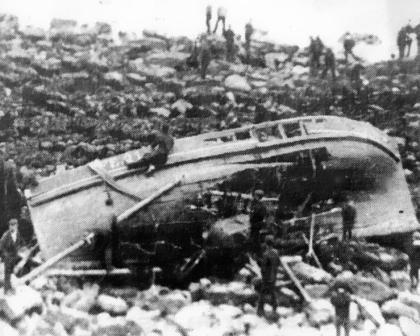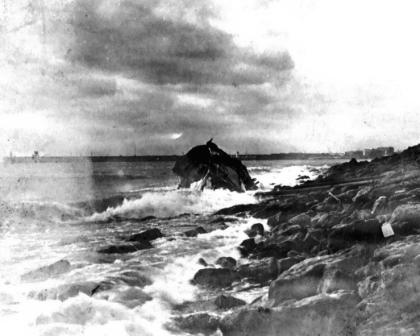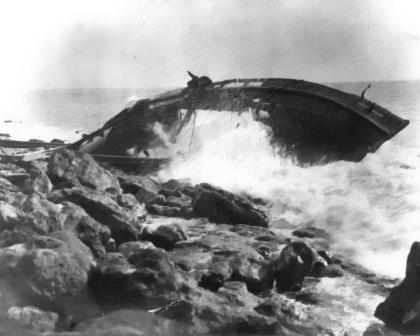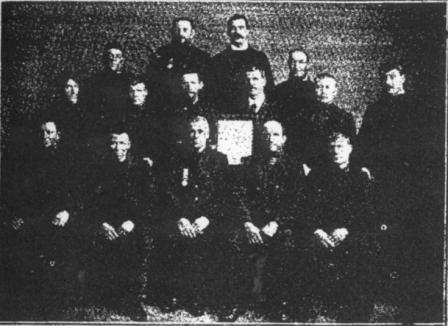| THE GOOD INTENT | THE GOOD INTENT | THE GOOD INTENT |
|---|---|---|
 |
 |
 |
| The Wreckage of the Lugger Good Intent: 1904 | ||
THE HISTORY OF THE FOLKESTONE LIFEBOATS |
| THE RESCUE STORY |
THE INQUEST ON THE CREW OF THE LUGGER PRIDE AND ENVY OF EASTBOURNE |
LATER NEWS COMMENT | SILVER MEDAL AWARDED | THE RNLI SILVER MEDAL PRESENTATION |
| THE GOOD INTENT | THE GOOD INTENT | THE GOOD INTENT |
|---|---|---|
 |
 |
 |
| The Wreckage of the Lugger Good Intent: 1904 | ||
THE RESCUE OF THE CREW OF THE GOOD INTENTFolkestone Herald October 8th 1904STORM & DISASTERFISHING BOATS IN WEDNESDAY NIGHT′S HURRICANETWO SMACKS WRECKED AT FOLKESTONE THREE MEN DROWNED GOOD INTENT DASHED TO PIECES CAPTAIN SAUNDERS AND HIS SONS IN DANGER LIFEBOAT TO THE RESCUE HEROIC DEED OF COXSWAIN COOK AND HIS CREW LIFEBOATMEN OVERBOARD TERRIBLE MIDNIGHT EXPERIENCES THRILLING ADVENTURES The storm of Wednesday night wrought havoc at Folkestone. Two fishing smacks were completely wrecked. The crew of an Eastbourne boat all perished, but the crew of the “Good Intent”, a Folkestone craft which also foundered were rescued by our gallant lifeboat crew. Nautical men had given warning early on Wednesday morning that a gale might be expected. The sunshine of the early morning died away, and before noon the sky had become overcast. Towards evening the breeze freshened considerably and rain fell at intervals. At nine o′clock the Folkestone fishing fleet, which was accompanied by some Rye, Shoreham and Newhaven craft, had not returned to port, and the velocity of the wind had so increased that almost a gale was raging. Fishermen′s wives and children flocked to the Stade and peered eagerly into the black night in the hope of catching a glimpse of the returning fleet. It was not long before a dozen lights were perceived by vigilant eyes. One moment on the crest of immense waves, and the next hidden from view in a valley of seas, the little vessels were to be seen running before the strong south–westerly winds, their gallant crews of three or four men bracing every nerve for the terrible ordeal which would face them as they turned the pier head. It was a quarter to ten when the first boat weathered the pier head, and on a full tide sailed into Folkestone Harbour. But what was that which had caused the masthead light in one of the vessels to disappear from view? Could a sailing smack have foundered? Quickly the Folkestone boats and those of other towns were counted, with the result that the “Good Intent” of Folkestone, a Newhaven vessel, and others from Rye and Brighton were found to be missing from the Harbour. Outside could be seen three crafts and it was known that neither of these was the one whose lights have been missed. Simultaneously a pang shot through the breast of all ashore. From out of the darkness two red flares were seen burning, and they clearly showed that they were being burned by a vessel that was being DRIVEN ON TO THE ROCKS at the foot of Copt Point. Another moment and two more red lights were distinguished. This was sufficient for the fisherfolk ashore. They knew too well that out amongst those angry waves some of their brethren were battling for their lives. A sudden rush was being made for the lifeboat house, when an explosion was heard and a moment later the reflection from a red rocket informed everyone that the crew of the lifeboat were being summoned. It was not long before the “Leslie” was withdrawn from her shelter and run down within a few feet of the water′s edge. The crew hastily clambered aboard in their cork life–belts and oilers and coxswain COOK at the helm encouraged his crew in making preparations for the launch. But what was the cause of all the hesitation and delay? Why was it that the boat was not pushed into the water? “We want the haul rope.” roared Coxswain COOK and instantly numbers of fishermen and boys swarmed to the Victoria Pier, and there hurriedly prepared to make tight a rope which had been connected with the bows of the lifeboat. “Are you all ready?” came a stentorian voice from the Pier, and as speedily there answered a voice in the affirmative.
“Let her go!” shouted Coxswain COOK, and the boat was pushed and pulled into the water. But the launch was unsuccessful. The terrific waves forced the bows of the gallant little craft round, and there it lay with the haul rope on, with its broadside meeting the full fury of the raging seas. A cry for more assistance rang out from the Victoria Pier. Away hurried many willing helpers to the Pier, and by the aid of the electric lights which were turned on they worked with might and main to pull the lifeboat′s bow seaward. Meanwhile those people who were standing on the Lees and other prominent positions could see that another vessel was in danger. While one was burning a red flare, another seemed to have set fire to something oily, with a view to impressing upon their would–be rescuers how imminent was their peril. Two red rockets discharged from the lifeboat house assured the sailors that assistance was forthcoming, and as no more distress signals were shown, it seemed that the crews fully understood by those answering rockets that all that was possible was being done. But the suspense was terrible. Out came the long pole and an effort was made to push the bow of the lifeboat into the water. The effect of the extra assistance on the ropes soon became manifest. “She moves! She′s off!” were the next cries to be heard, and then, amid the excited cheering of the onlookers and the firing of a green rocket, as a reassuring signal to those in distress, that the boat was launched, the bows forged out to sea. The rope was discharged from the lifeboat, and, under sail and oars it sped away from the sight of those on the beach. Women were amongst those who had assisted the lifeboat to float, and none the less energetic of these helpers were the wives and mothers of those who formed the crew of the lifeboat. At that moment there was a rush for the harbour and every point of vantage on the jetties, and the space round the little lighthouse, was packed with people. About 200 yards eastward of the pier one vessel had brought up, while another was a similar distance behind it riding at anchor. The lifeboat could be seen as it approached these, and after a slight stay passed by. They did not need assistance. A mere handful of men – all local fishermen – had, during the launching operation, taken a ferry boat, and in it had pulled out to the nearest two vessels, taking with them long thick ropes. With these they made the smacks fast to the jetties, and gradually they were BROUGHT INTO PORT. But the excitement grew greater after midnight. Up to that time the lights of two vessels had been seen off Copt Point but now one of them had disappeared. At half–past one the little lifeboat was seen making for the mouth of the harbour. It was a moment that will long be remembered by all who lined the jetties as they peered into the stern of the boat and asked themselves “Have they got the crews” but not a soul ventured to remark upon the result of the lifeboat′s expedition. Two minutes later and an excited fisherman shouted “Have you got ‘em ‘Cookie’?” Back came the reply from the coxswain. “We have got Jack SAUNDERS.” Another query. “And his crew?” roared out of the darkness, and as readily came the answer “Yes!” This was the signal for a tremendous cheer from the crowd. But no sooner had it died away than the coxswain of the lifeboat was asked, “What about the other boat?” In a mournful tone COOK replied “She′s gone down.” And when as though in fear a fisherman asked, “Have you got her crew?” the large crowds which had been listening to the conversation were awe–stricken by the reply “No, they have gone down too.” The rescued crew explained that their boat had been broken up on the Mole rocks, a quarter of an hour after they had been taken off, but they had not seen another vessel anywhere near them, until a protruding mast passed by the bow of their own boat. They knew that a boat had been sunk and was being driven along by the swell. An informal muster of the ships was called, and it was found that N.N.21 an Eastbourne fishing smack was missing.
After about five minutes the lifeboat put out again to the one smack which remained at anchor, but returned to port shortly afterwards only to be recalled to sea at the cry of “Her cable’s parted.” It was not long before every effort was made to bring this boat into harbour, this being successfully accomplished just before two o′clock. Nothing more could be done that night, and the crowds dispersed. But not so the fisherfolk. They waited until the hour of day–break revealed to them the “Good Intent F.E.21.” lying smashed to pieces at the foot of Copt Point, and a protruding mast telling that another fishing smack (N.N.21) lay at the bottom of the sea within a very short distance of low water mark. CAPTAIN SAUNDERS TELLS HIS TALETo a Herald representative Mr Jack SAUNDERS narrated the circumstances which led to the destruction of the boat of which he was both master and owner. He Said: “We had got right opposite Folkestone and when we were hauling in round the pier, a very heavy squall of wind came and blew our mast in three pieces over the side. That caused us to drive away, and we had to get an anchor overboard as quickly as possible for fear of driving on the rocks. We showed red flares, and after we had shown a second lot the maroon went up for the lifeboat. We laid there some time but the lifeboat did not come so we showed another flare. We had burnt five flares and had only two more left, and we had no matches. My son went below and stirred the fire up, and found one cinder that was a bit red. We then SOAKED AN OLD JACKET in paraffin oil, and set that alight with the cinder. That burnt in a bucket, and the lifeboat saw that and made for us. They came towards us, but the wind and sea were so strong that they were taken clean past us. The crew were some time getting her round. As she came up to us again she shipped a heavy sea that washed two of the men overboard from the lifeboat, and all the oars on one side were knocked out. They got them aboard and pulled up close in shore. They came again towards us, and let go the anchor and sheered right down alongside. We threw a rope to them, and pulled the two boats together, and got out as quickly as possible into the lifeboat. My two sons would not leave before I got clear of my boat first. The boat had not filled with water, but as several heavy seas had broken over her, she had parted from one anchor. We had not left her a quarter of an hour before she struck the ground, and at the same time a great sea struck her, and she drove in on to the rocks, where she lay this morning. As the tide began to flow, she was knocked in by the sea farther on to the rocks, and she heeled over on to her side and the bottom was knocked out of her.About an hour before the lifeboat came to us we saw the mast of a boat drifting towards us. The ground swell was knocking her along. A heavy sea knocked her just inside of us, and although we tried to avoid her, she struck us, and passed by. This was the first that we knew of a boat going down.” The “Good Intent” was insured in the Folkestone Fisherboat Association for a small sum but that will hardly be equivalent to the bill paid for repairs to the boat some eighteen months ago. At the age of 15 years Jack SAUNDERS, as he is popularly known, took to the sea. He sailed for six years with his father, and then went as master of a boat, which position he has filled ever since. The “Good Intent” was HIS OWN PROPERTY and it had been in his possession for about 15 years. She was a seaworthy boat although not so large as some of the craft in the harbour. Two years ago the same Captain and crew were returning from whiting fishing when they shipped a heavy sea, which knocked her after part clean under the water, washing lines and all the fish overboard. That was a very narrow escape. Twelve months before that the “Good Intent” shipped two seas just inside the Varne lightship. One side of the bulwarks was laid flat on the edge of the sea, but happily the craft righted itself. Since that the owner has been put to considerable expense by repairs, new gear, lines, trawls, etc., and now, after two very bad seasons, as he himself has said “his all is gone.” Mr John SAUNDERS SENR. is 53 years of age. He lives at No. 67, Dover Street and has to support a wife and four children. Mr John SAUNDERS JUNR. has sailed under his father since he took to the sea. He is 32 years of age and has a wife and three children Mr Edward SAUNDERS, of 16, North Street, has also sailed with his father since he took to the sea. He is 26 years of age, and is married, but has no family. All three shared equally in the “takes” of the fishing, which, during last season, and so far this season have been anything but lucrative. Up to the time of going to sea on Wednesday morning, they had only earned 10s from the proceeds of the fish sales, this representing a half week′s profit. Some years ago a boat belonging to Mr J SAUNDERS′ father, now a veteran “salt” was sunk when coming round the Pier in a gale, but without loss of life. THE COXSWAIN′S COMMENT.Steven COOK, coxswain of the lifeboat, in an interview with a “Herald” reporter, said that it was a very bad place to launch the boat where the present launching station was, and will probably be altered when half the crew have lost their lives one night when the boat is being launched. They should find some more suitable place, he said. The tide was half down at the time, and when the lifeboat reached the smack there was a great danger of the bottom of the boat being knocked out. He says the seas were enormous.LIFEBOATMAN′S STORYDavid PHILPOTT, the caretaker of the lifeboat, gave a graphic description of the launching of the “Leslie” and the rescue of the crew of the “Good Intent” to a “Herald” reporter after his return. PHILPOTT who is 59 years of age, will be remembered as the oldest Folkestone lifeboatman, and the man who received a bronze medal, inscribed “He bravely did his duty.” for the efforts he made in endeavouring to effect a rescue of the crew of the Benvenue on the 11th November 1891. He said: “I was standing in the Fish Market on Wednesday evening, when I saw the coxswain, Mr COOK, who had just come in from fishing. He said to me, “Have you got the keys, Dave?” (meaning the keys of the lifeboat house), and I said ‘Yes.’ All three of us then went along to the lifeboat house and the coxswain gave the order for the firing of the maroon. The maroon went off, and the boat was shoved out of the house. While it was on the beach the crew got into it, and haul ropes were put out from the end of the Pier. We pulled down to the sea, but the waves were so strong that we were driven broadside on. While here the lifeboat FILLED SEVERAL TIMES with water. It was twenty–five minutes from the time the maroon fired before we were properly launched, and when we got opposite the pier we got rid of the launching pole which had fouled the bows. When we got to the easternmost side of the pier we spoke a smack which was lying there at anchor, and found that she was all right. The next we saw was a red flare off Copt Point, and we went down towards it. There was no other light to show us what vessel it was, but COOK could just see an object. We went down with the sail up, and it was when we neared it the coxswain asked who it was. A reply came from the smack, “It′s Jack SAUNDERS.” We were just astern of the smack when a heavy sea caught us and washed young Leonard SAUNDERS and Jack SPEARPOINT out of the boat.But the next heavy sea washed the boat right on top of them and we managed to scramble them on board. We turned round and pulled our oars towards the smack, and after a bit we got our anchor down. We sheered down alongside and asked Jack SAUNDERS and his two sons if we could give any assistance to the boat. Jack replied, ‘No, we only want to get out of it.’ I fancied it was striking on the rocks as it lay there, for it was only in water six or seven feet deep. While we were turning round to regain the smack we saw what looked like a mast go by. Mr COOK thought it was a buoy, but when we got up to it we could see that it was a main mast of A SUNKEN SMACK and we could hear the sail flapping on the top of the water. There was nobody on it, and we could not hear any cries for help. Then we brought them back to harbour, and had just landed them when the people on shore shouted to us to go out again. Our inspector, Capt. FOOTE, R.N. who had come down for the practice launch that morning stood in the harbour when we came in. We went out in response to this second call and spoke a Shoreham smack that was lying off there. We asked if they wanted us, and they said ‘No.’ We returned to the harbour again, and while the coxswain was up the steps talking to Capt. FOOTE there was another shout that we were wanted, and the coxswain jumping into the boat, said ‘Let her go again, boys.’ This time we went straight to the same boat and asked if she was all right, or if he wanted us and she replied that she did not, she was all right. When we returned Capt. FOOTE said ‘you had all better go home and get a shift.’ We went home, but NONE OF US TO BED. We shifted, and came out again. I had only put the boat away that day at half past five, after launching it for the practice in the morning” “What do I think of the Leslie? Well she is the best boat I have ever been in. She′s better than the McConnel Hussey. As quick as the water came in on one side on the other she was empty again and not only that, she doesn′t draw so much water by 8 or 10 feet, and that makes the greatest difference in getting off.”
All the crew are unanimous in the opinion that although the present lifeboat launching station is the best obtainable on the beach, some place should be built on the lee side of the South–eastern Railway Company′s Pier, where the boat could be lowered, either by davits or by means of a slide, into the water. The lifeboat crew were S. COOK (cox), E. MAJOR (2nd cox), D. PHILPOTT, G. PHILPOTT, F. FEATHERBY, L. SAUNDERS, J. SPEARPOINT, R. BAKER, W BAKER, J. HALL, F. HALL, C. TAYLOR, AND A BRIGHTON FISHERMAN WHOSE NAME IS UNKNOWN. In his report to the Lifeboat Institution the coxswain says that the maroon was fired at 10.25 p.m. and the lifeboat was afloat 25 minute later. They finally returned to harbour at half–past two. The boat pulled well against the wind and it behaved splendidly throughout. It had an anchor lost, an oar broken and a launching–pole lost before returning to the shore. L SAUNDERS and J. SPEARPOINT who were washed out of the boat have been recommended for double pay by the Local Committee of the Lifeboat Institution. EASTBOURNE CREWA PATHETIC INCIDENTThe Eastbourne crew who were all drowned, consisted of “Charlie” BROWN, master, Jesse GOLDSMITH, and S BARNARD. They left Folkestone in their boat “N.N.21.” at the same time as the Folkestone fishermen. On the previous days of the week the master′s little boy, aged nine years, had accompanied him, but it was thought that Wednesday′s weather was not such as would be fit for the child to be afloat. His father then had left him ashore with some friends. It was not until the following morning about ten o′clock when playing with some smaller companions, that little BROWN heard of the dreadful end which had befallen his father and the crew. It was on overhearing a conversation that the sad event became known to him, and the manner in which the news was received by him was heartrending to onlookers. The juvenile was already motherless.THE INQUEST INTO THE LOSS OF THE CREW OF THE PRIDE AND ENVY OF EASTBOURNEA BODY RECOVERED
On Thursday afternoon the body of Jesse GOLDSMITH was washed ashore to the east of Copt Point and
Yesterday afternoon the Borough Coroner (Mr. G. W. HAINES), assisted by a jury investigated the circumstances attending the death of the fisherman, the inquest being held at the Woodward Institute.
|
| The Crew at the Presentation |
|---|
 |
| The Crew of the Lifeboat |